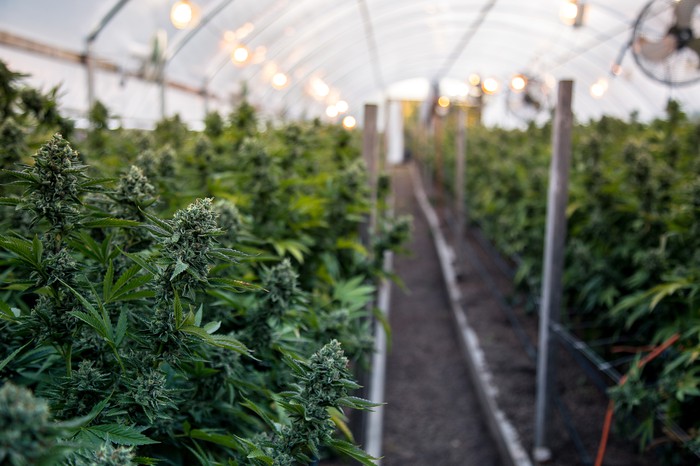Are Marijuana Stocks Actually Value Stocks? — The Motley Fool
Marijuana Stocks, Finance, & Investing October 27, 2018 MJ Shareholders 0

The marijuana industry has entered a new phase. As of Oct. 17, recreational marijuana is now legal in our neighbor to the north, making Canada the first industrialized country in the world to have given the green light to adult-use weed. When the industry is fully ramped up, it’s expected to result in billions of dollars in added annual sales, which is precisely why investors have piled into pot stocks since the beginning of 2016.
However, some pundits would suggest that marijuana stocks are grossly overvalued as a result.

Image source: Getty Images.
Some pot stocks may offer more value than you realize
For instance, Tilray (NASDAQ:TLRY) was sporting a $28 billion valuation at its peak in September when shares hit $300 on an intraday basis. Tilray had rallied on a combination of extremely high short-sale borrowing costs, news events that included the first cannabis oil shipment to Germany, and the expectation that it would be likely to find a partner in the beverage or tobacco industry relatively soon.
Yet, the reality for Tilray and its shareholders is that the company is expected to spend heavily to expand its production capacity, broaden its product line, and push into international markets. Even with a rapid rise in sales, this will probably result in the company losing money in each of the next two years (including the current fiscal year).
But this isn’t the case for all marijuana stocks. Some are expected to be profitable on a recurring basis in the post-legalization environment, and a handful might actually pass for value stocks.
How the heck is that possible when the industry has forward price-to-earnings ratios that are mostly in the triple digits? The answer lies in the fact that “value” can have an arbitrary definition, and is truly in the eye of the beholder. Traditionally, a value stock would be defined as a company that trades at a fundamental discount to its peers and/or the broader market. Solely taking price-to-earnings ratios into account, no marijuana stock would be considered a value stock.

Image source: Getty Images.
But things change if we examine the five-year growth potential of marijuana stocks. Although Wall Street has yet to offer consensus five-year growth projections — institutions don’t have any idea what the industry will look like even two years from now, let alone five — there are a few marijuana stocks that would likely be valued at a price-to-earnings-growth ratio (PEG ratio) of less than 1. Generally speaking, a PEG ratio of under 1 signals a value stock.
It’s possible these high-growth marijuana stocks are value stocks
With the understanding that there’s some fluidity to growth figures (especially since there are no Wall Street five-year growth estimates of yet), the following pot stocks could actually pass as both growth and value stocks.
Aphria
Among the biggest growers, the only one that’s remained profitable over the past couple of years is Aphria (NASDAQOTH:APHQF). When at full capacity, Aphria is expected to yield 255,000 kilograms of cannabis annually, with its two largest facilities, Aphria One and Aphria Diamond, expected to be complete by January 2019. Aphria’s focus on alternative cannabis products like oils and concentrates (concentrates, along with vapes, edibles, and infused beverages, aren’t legal yet) should allow it to produce superior margins relative to the average cannabis grower.
According to Wall Street, Aphria is currently valued at 31 times next year’s full-year earnings per share. That alone is considerably lower than most pot stocks, which will either be losing money or deliver marginal profitability. But Aphria is forecast to generate 437% sales growth in fiscal 2019, 180% sales growth in 2020, and will likely see a significant uptick in 2021 revenue, too. I’d suggest it’s all but a certainty at this point that Aphria’s PEG ratio (were one officially available) would be under 1, making it an intriguing value in an otherwise frothy industry.

Image source: Getty Images.
OrganiGram Holdings
Moving to the small-cap arena, Atlantic-based grower OrganiGram Holdings (NASDAQOTH:OGRMF) may offer a value proposition to investors despite its forward P/E ratio of 46.
OrganiGram’s uniqueness comes from its geographic location — there aren’t any major growers based in the Atlantic region — and its proprietary three-tiered growing system. With some of its peers working with 1 million square feet of production space and expected to yield “just” 75,000 kilograms of weed a year, OrganiGram’s peak production potential of 113,000 kilograms spanning just 480,000 square feet is simply incredible.
Like Aphria, OrganiGram is also expected to focus on alternative cannabis products to boost its bottom line. Angling to generate half of its medical cannabis sales from high-margin oils, and taking into account its production efficiency, OrganiGram should have considerably more attractive operating margins than its similarly sized peers. With forecasted sales growth of 85% in fiscal 2018 and 722% next year, OrganiGram would probably have a PEG ratio of under 1, if there were an official Wall Street estimate.
CannTrust Holdings
There’s also Ontario-based CannTrust Holdings (NASDAQOTH:CNTTF), which currently sports the lowest forward P/E of any marijuana grower at 29.
When CannTrust is complete with its expansion, it expects to have “in excess of 100,000 kilograms” of annual yield, according to the company. Most of this will come from expansion at the company’ Niagara Greenhouse facility, which is a huge hydroponic grow project. Hydroponics involves growing plants in a nutrient-rich water solvent as opposed to soil. The use of hydroponics combined with the company’s perpetual harvest system (i.e., a series of moving containerized benches) should lead to steadier production and lower long-term growing costs on a per-gram basis.
Looking ahead, Wall Street expects CannTrust to grow sales by 250% in fiscal 2018, and then another 164% next year. That seems like a pretty good recipe for a PEG ratio of under 1, thus making CannTrust a marijuana value stock.

Image source: Getty Images.
A word of caution
Of course, I’d be remiss if I didn’t mention the fact that no marijuana growers are currently profitable on a recurring basis, even if some pot stocks have been reporting per-share profits to date. That’s because International Financial Reporting Standards (IFRS) in Canada require growers to adjust the value of their crop throughout the grow cycle.
Since IFRS accounting allows companies involved in the agricultural industry to choose where on their income statement they’ll reflect this change in value, a ramp-up in capacity has produced some huge upward adjustments in profit. Companies like Aphria, OrganiGram, and CannTrust, while profitable thus far, wouldn’t be generating positive operating income if strictly looking at these businesses from the basis of sales and operating expenses.
In other words, per-share profits to date should come with huge asterisks attached. Keep this in mind as you attempt to value stocks in the marijuana industry.

MJ Shareholders
MJShareholders.com is the largest dedicated financial network and leading corporate communications firm serving the legal cannabis industry. Our network aims to connect public marijuana companies with these focused cannabis audiences across the US and Canada that are critical for growth: Short and long term cannabis investors Active funding sources Mainstream media Business leaders Cannabis consumers










No comments so far.
Be first to leave comment below.